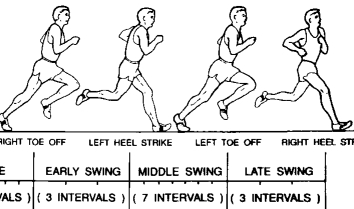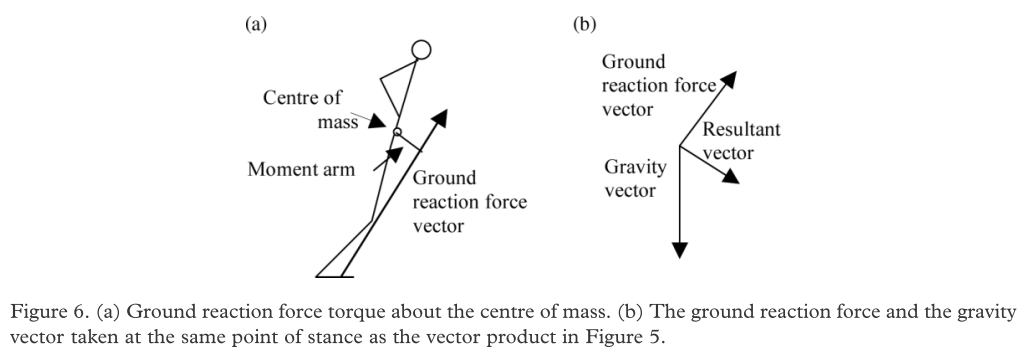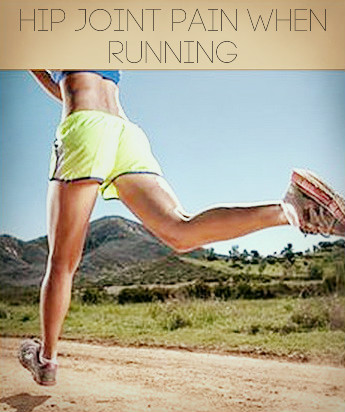A study by Montgomery et al. discovered that most heel strike runners used hip flexion for forward propulsion when running, which may be a potential origin of hip joint pain when running. Their finding contradicts earlier studies which demonstrated that heel strike runners used ankle plantarflexion (i.e. toe push-off) for forward propulsion.
Potential Origin of Hip Joint Pain When Running
In the current study, the discovery that the hip muscles were the main source of forward propulsion in heel strike running, bolsters the idea that using the hips to accelerate the mass of the body may cause hip joint pain when running.

- Mann et al. also found that the hips were used primarily for forward propulsion in heel strike runners.
Most researchers now believe using the hips for propulsion drives the swing leg more forward, causing the foot to land in front of the body. The net result is rapid, but temporary braking at touchdown, exerting high compression on the knee-joint which is why, according to Winter et al., the notion that hip extension produces propulsion is not universally accepted, and here’s why:
- When the foot lands in front of the body at touchdown, more muscular work is needed to move the body’s mass from behind to in front of the foot at the end of the stance.
- During this time, of which ground contact is very long, the hips are also used for stabilization. As the mass of the body moves in front of the knee, hip extension is initiated to propel the body.
Needless to say, the hip joint appears to have a big job in heel strike running. Being used for forward propulsion is an easy trap for hyperextension of the hip joint resulting in painful flare-ups. Furthermore, almost all existing treatments are aimed at improving hip strength.
But, is hip weakness the main symptom that characterizes hip joint pain when running?
Forefoot Running: Safer on the Hip Joint
A better understanding of biomechanics has led to more refined treatments. For instance, by switching to forefoot running, associated with fewer side effects than heel strike running, makes it possible for runners to run without hip joint pain.
That biomechanical adjustment is important because we now know that the ground reaction force in forefoot running is not propulsive.
- Romanov and Fletcher demonstrated that the ground reaction force is a reactive force, not propulsive in forefoot running, and there is no ground reaction from the hips.

Studies on Kenyan barefoot runners, who are also forefoot runners, showed that the hip extensor muscles were not active because these muscles were not used for propulsion during stance.
Romanov and Fletcher reasoned that the forward momentum is gained because the body is always falling forward in forefoot running. Simply lean forward very subtly, let your foot catch you from falling by letting it land close to your hips, making sure both knees are slightly bent at all times, will blunt the urge to push with your hips.
More From Run Forefoot:
Tarsal Tunnel Syndrome in Running – Repetitive ankle dorisflexion at touchdown, a common action in heel strike running, identified in tarsal tunnel syndrome.
Althetic Tape – Latest findings on the benefits of using KT Tape for running.
Barefoot Running Injuries – Heel striking when running barefoot manifests more injury as opposed to heel striking in running shoes.
Preventing Injury – Running with less injury means landing with a forefoot strike, not a heel strike.
Shoes – 30 of the best, most popular minimalist shoes that will help you maintain exceptional forefoot running form.
References:
Cavanagh, P. R., and LaFortune, M. A. (1980). Ground reaction forces in distance running. Journal of Biomechanics, 11, 487–49
Montgomery et al. Electromyographic analysis of hip and knee musculature during running.Amer J Sports Med, 1994; 22(2):272-278.
Ounpuu S: The biomechanics of running: A kinematic and kinetic analysis. Instr Course Lect 39: 305-318, 1990
Romanov, N and Fletcher G. Runners do not push off the ground but fall forwards via a gravitational torque. Sports Biomech, 2007; 6(3):434-452.
Winter DA: Moments of force and mechanical power in jogging. J Biomech, 16: 91-97, 1983.
Bretta Riches
BSc Neurobiology; MSc Biomechanics candidate, ultra minimalist runner & founder of RunForefoot. I was a heel striker, always injured. I was inspired by the great Tirunesh Dibaba to try forefoot running. Now, I'm injury free. This is why I launched Run Forefoot, to advocate the health & performance benefits of forefoot running and to raise awareness on the dangers of heel striking, because the world needs to know.
Latest posts by Bretta Riches (see all)
- Heel Strike Running Causes Slipped Discs - 25/04/2024
- How to Train Yourself to Not Heel Strike When Running - 24/04/2024
- Cushioned Running Shoes Found to Be Bad for Ankles - 23/04/2024


Leave a Reply